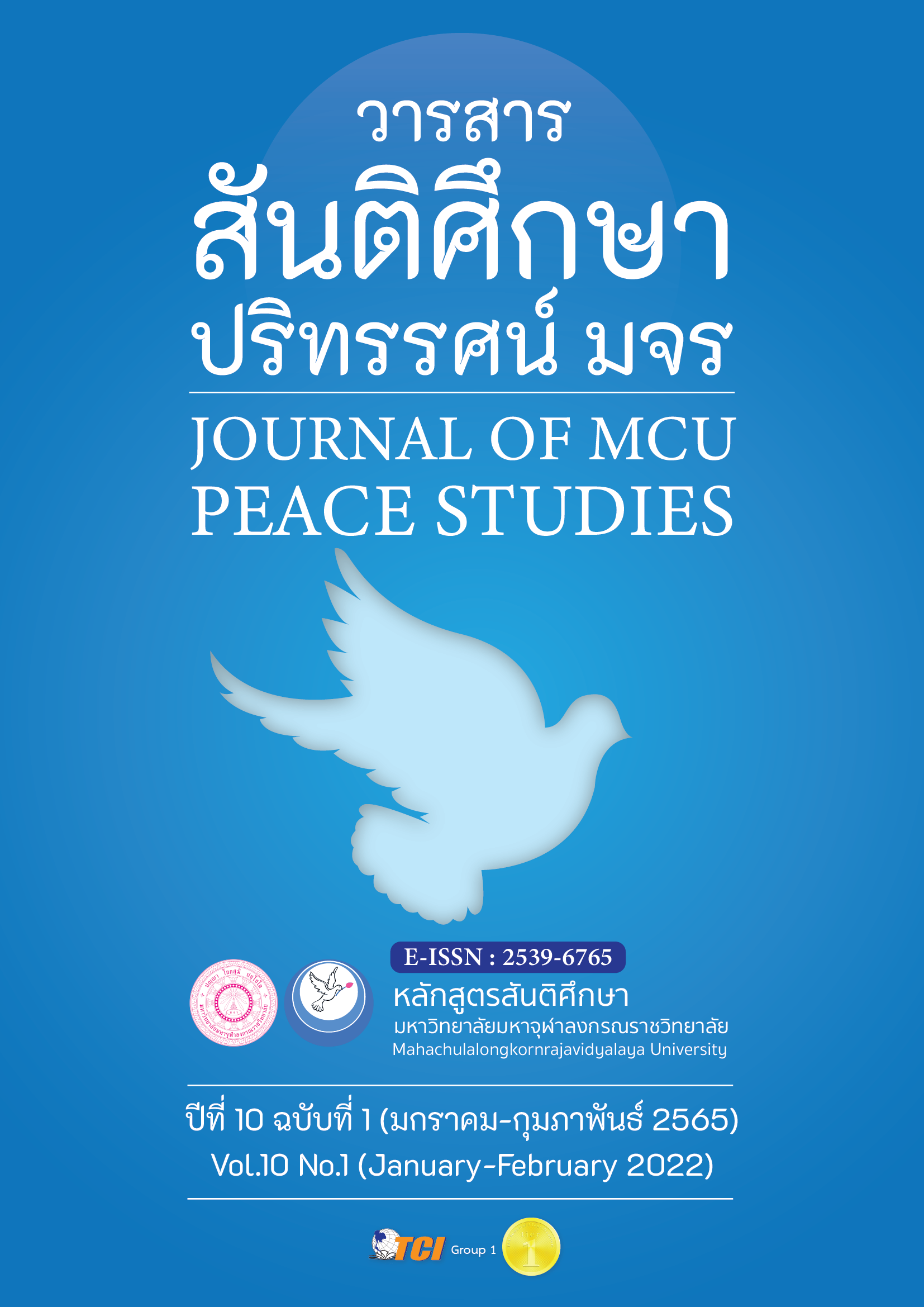การวางแผนปฏิบัติงานอย่างมีส่วนร่วม ในกระบวนการดูแลแบบประคับประคองด้วยพุทธสันติวิธี
Main Article Content
บทคัดย่อ
การดูแลผู้ป่วยที่ดีนั้นจำเป็นต้อง ดูแลผู้ป่วยแบบองค์รวม คือดูแลทั้ง กาย ใจ มิติทางสังคม ในปัจจุบันนั้นการแพทย์แผนตะวันตกนั้นมีวิธีการ การดูแลประคับประคอง ซึ่งหมายถึงการดูแลผู้ป่วยเพื่อเพิ่มคุณภาพชีวิตของผู้ป่วยและครอบครัวที่ประสบปัญหาการเจ็บป่วยที่ร้ายแรงและอาจถึงแก่ชีวิต และถือเป็นส่วนสำคัญในการดูแลผู้ป่วยโรคมะเร็ง ซึ่งเป็นโรคที่รักษาไม่หายขาดและผู้ป่วยมีโอกาสเสียชีวิตจากโรค การดูแลแบบประคับประคองทำให้คุณภาพชีวิตของผู้ป่วยรวมถึงคุณภาพชีวิตของครอบครัวของผู้ป่วยดีขึ้น ปัจจุบันประเทศไทยได้มีการนำการดูแลแบบประคับประคองแบบองค์รวมเข้าไปเป็นส่วนหนึ่งของสถานพยาบาลทั้งของภาครัฐ และเอกชน แต่อย่างไรก็ตามจากประสบการณ์ของผู้เขียนในฐานะแพทย์ผู้เชี่ยวชาญการดูแลแบบประคับประคอง ผู้ซึ่งทำงานด้านการดูแลประคับประคองในผู้ป่วยโรคมะเร็งมามากกว่า 15 ปี พบว่า ปัญหาและอุปสรรคในการนำการดูแลประคับประคองมาใช้ให้ให้มีประสิทธิภาพ คือ การขาดความรู้สึกมีส่วนร่วมและความรู้ความเข้าใจจากผู้ร่วมปฏิบัติงานซึ่งเป็นหัวใจสำคัญ คำถามว่าจะทำให้เกิดขึ้นได้อย่างไรเป็นสิ่งที่ผู้เขียนมุ่งค้นหาคำตอบ บทความวิชาการนี้ผู้เขียนนำบทเรียนที่ค้นพบผ่านประสบการณ์ตรงในการแก้ปัญหาของหน่วยงานที่รับผิดชอบการดูแลแบบประคับประคอง โดยนำหลักพุทธสันติวิธีและกระบวนการปรับปรุงคุณภาพมาใช้ในการวางแผนปฏิบัติงานการดูแลประคับประคองอย่างมีส่วนร่วมในศูนย์มะเร็ง ส่งผลให้ผู้ร่วมปฏิบัติงานเห็นความสำคัญและรู้สึกเป็นเจ้าของในแผนปฏิบัติงาน เกิดความกลมกลืนสมานฉันท์ในการทำงานเป็นทีม ผู้เขียนคาดหวังว่าบทความนี้ จะสามารถเป็นตัวอย่างหนึ่งที่ผู้อ่านสามารถนำไปประยุกต์ใช้ในการวางแผนปฏิบัติงานการดูแลประคับประคองในหน่วยอื่น ๆ ต่อไป
Article Details

อนุญาตภายใต้เงื่อนไข Creative Commons Attribution-NonCommercial-NoDerivatives 4.0 International License.
ทัศนะและความคิดเห็นที่ปรากฏในบทความในวารสาร ถือเป็นความรับผิดชอบของผู้เขียนบทความนั้น และไม่ถือเป็นทัศนะและความรับผิดชอบของกองบรรณาธิการ ยินยอมว่าบทความเป็นลิขสิทธิ์ของวารสาร
เอกสารอ้างอิง
American Society for Quality. (2021). ASQ: Learn About Quality. Retrieved January 31, 2021, from https://asq.org/quality-resources/pdca-cycle.html.
Anderson, F. et al. (1996). Palliative Performance Scale (PPS): A New Tool. Journal of Palliative Care, 12(1), 5-11.
Carr, P. (2017). Achieving Peace, the End of the Part meeting minute. Nonthaburi: National Health Commission Office.
Chinda, M. et al. (2011). Reliability and validity of a Thai version of the Edmonton Symptom Assessment Scale (ESAS-Thai). Journal of Pain and Symptom Management, 42(6), 954-960.
Ferrell, B.R. et al. (2017). Integration of Palliative Care into Standard Oncology Care: American Society of Clinical Oncology Clinical Practice Guideline Update. Journal of Clinical Oncology, 36(1), 96-112.
Hussain, S.T. et al. (2016). Kurt Lewin’s process model for organizational change: The role of leadership and employee involvement: A critical review. Journal of Innovation & Knowledge, 3(3), 123-127.
Jua-upatum, R. (2021). Palliative Specialist Nurse. Interview. March, 1.
Kotter, J.P., & Cohen, D.S. (2012). The Heart of Change. New York: Harvard Business Review Press.
Lertsanguansinchai, P. et al. (2009), End of life care improving care of the dying (6th ed.). Bangkok: Aksorn Sampan.
Nakawiro, P. (2017). The Palliative Care Outcome in Palliative Cancer Patients in Phra Nakhon Si Ayutthaya Hospital. Journal of Preventive Medicine Association of Thailand, 7(1), 11-23.
National Health Commission Office. (2014). The National Strategic Plan on Health Promotion for Good Death 2014-2016. Nonthaburi: Samdee Printing Equipment Ltd.
Oken, M.M et al. (1982). Toxicity And Response Criteria of The Eastern Cooperative Oncology Group. American Journal of Clinical Oncology, 5, 649- 655.
Patthanaruangli, A. (2016). List disease of Palliative care and Functional unit. Nonthaburi: Department of Medical Services.
Phosri, T. (2021). Advanced internal medicine and surgical nurse practitioner. Interview. March, 1.
Phra Dhammapitaka (P.A.Payutto). (2002). Dictionary of Buddhism (Numerical Dhammas Edition). Bangkok: Publishing of Suetawan.
Phramaha Hansa Dhammahaso (Nitibunyakorn). (2011). Peace means: Buddhist peaceful means: The Integration of Principles and Tools for Conflict Management. Bangkok: 21 Century Ltd.
Sawasdeenarunat, V., Taneerat, A., & Wisettharn, T. (2015). The Development of a Palliative Care Model for Terminal Cancer Patients at Maharaj Nakhon Si Thammarat Hospital. Nursing Journal of the Ministry of Public Health, 25(1), 144-156.
Smith, T.J. et al. (2012). American Society of Clinical Oncology Provisional Clinical Opinion: The Integration of Palliative Care into Standard Oncology Care. Journal of Clinical Oncology, 30(8), 880–887.
Suwanvecho, B. (2021). Development of Dental services process for children based on the mission of the Police Hospital and the new-normal life under the COVID-19 situation. Advance Police Administration. Bangkok.
Temel, J.S. et al. (2010). Early palliative care for patients with metastatic non-small-cell lung cancer. N Engl J Med, 363(8), 733-742.
The International Agency for Research on Cancer (IARC), World Health Organization. (2018). Latest global cancer data: Cancer burden rises to 18.1 million new cases and 9.6 million cancer deaths in 2018: PRESS RELEASE N° 263. Retrieved September 12, 2019, from https://www.who.int/cancer/PRGlobocanFinal.pdf.
Thich Nhat Hanh (2017). The art of communicating (Tantasathien, J., Translator). Bangkok: Nation Book.
Thich Nhat Hanh. (2012). Work. California: H Parallax Press.
Watanabe, S.M., Nekolaichuk, C.L., & Beaumont, C. (2012). The Edmonton Symptom Assessment System, a proposed tool for distress screening in cancer patients: development and refinement. Psycho-Oncology, 21, 977-985.
World Health Organization. (2020). WHO Palliative Care – Key facts. Retrieved November 12, 2021, from https://www.who.int/news- room/fact-sheets/detail/palliative-care.


